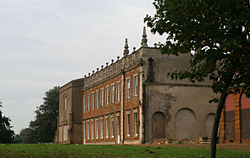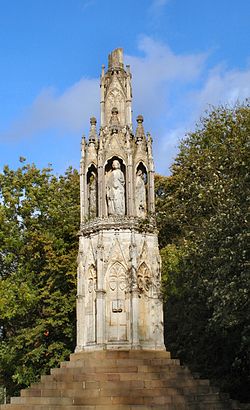Delapré Abbey
| Delapré Abbey | |
| Northamptonshire | |
|---|---|
 Delapré Abbey - the south facade | |
| Location | |
| Grid reference: | SP759592 |
| Location: | 52°13’29"N, -0°53’22"W |
| History | |
| Country house | |
| Information | |
| Owned by: | Borough of Northampton |
Delapré Abbey is a country house in Northamptonshire near the county town, Northampton. It stands on the site of a mediæval monastery, hence its name, which after the Dissolution passed to the Crown and thence to the Tate family.
After much later use as a private residence and in war service, the abbey was converted for use as the Northamptonshire County Records Office and the County Record Society. Currently the house is empty and debate continues locally over its future use. The building is Grade II* listed.
Monastery
The Abbey of St Mary de la Pré (The Abbey of St Mary in the Meadow) stood in the meadows of the River Nene to the south of Northampton. It was founded as a nunnery about the year 1145 and belonged to the congregation of the great Abbey of Cluny in Burgundy.
The abbey was founded by the Earl Simon de Senlis during the reign of King Stephen and held a Royal Charter from King Edward III. At its founding, the abbey was endowed with land at nearby Hardingstone and held the churches at Earls Barton, Great Doddington and Fotheringhay, the grants confirmed by the Earls of Northampton, who were also Kings of Scots: Malcolm IV and William. King Edward increased their holdings with the churches of Wollaston and Filgrave and also granted them the advowson of the church at Fyfield, Hampshire. He is recorded as giving "ten beams" towards the repair of the church in 1232, and another five oaks for work on the Refectory in 1258.
Delapré was one of only two Cluniac monasteries of women built in England (the other being Arthington Priory in Yorkshire). Monasteries in the congregation were supervised directly by the great abbey at Cluny. Typically a dozen to twenty nuns resided at the abbey at any one time. The Guild of Weavers at Northampton made an annual procession to the Abbey church each Easter Monday where, according to the ordinances of the Guild in 1431, they would offer up "...tapers before the ymages of the Trynitie and our Lady."
Nearby was the Cluniac Abbey of St Andrews, now gone but which lay in the north-west corner of the walled town depicted in the Speed map of 1610, which was founded by Simon de Senlis, Earl of Northampton, the father of the founder of Delapré.
Like all the other monasteries of England and Wales, the abbey was surrendered to the Crown during the Dissolution of the Monasteries, closing in 1538, and came into private hands.
The Eleanor Cross

One of only three remaining Eleanor Crosses is located at the Hardingstone end of the Delapré Abbey estate. The body of Queen Eleanor, wife of Edward I, rested at the Abbey on its journey from Lincoln to London. The king erected the crosses to mark the passage. The cross was begun in 1291 by John of Battle; he worked with William of Ireland to carve the statues.
A short history of the Abbey

- 1145 - Delapré Abbey was built by Simon, the son of Simon de Senlis, the 2nd Earl of Northampton.
- 1290 - The death of Eleanor of Castile, the wife of Edward I and Queen of England. The cortège from Lincoln stopped at Delapré Abbey for the night on the way to London. The ground at the top of the hill was consecrated and an Eleanor cross erected.
- 1460 - The Battle of Northampton between the Yorkists and Lancastrians was fought at Delapré.
- 1538 - Under the dissolution of the English Reformation, King Henry VIII forced the Abbey to surrender to the Crown.
- 1543 - The Crown rented the site and grounds of the former abbey to a tenant.
- 1550 - The Crown sold the Delapré estate to the Tate family.
- 1756 - Sir Charles Hardy, Governor of New York, husband of Mary Tate, sold the estate to Edward Bouverie for £22,000.
- 1905 - The Bouverie family rented the estate to John Cooper, a Northampton boot and shoe manufacturer.
- 1914 - Miss Mary Bouverie moved back to the Abbey.
- 1940 - The War Office took over the Abbey. Miss Bouverie moved to Duston and later returned to a room over the stables in 1942; she died on 20 January 1943.
- 1946 - The Northampton Corporation purchased the estate for £56,000.
- 1948 - The War Office gave up its use of the Abbey house.
- 2005 - Northampton Borough Council announced plans to form a new Delapré Abbey Trust.
- 2012 - The clock on the Stable block was fixed just before the Queens Jubilee July 2012. The chimes of the clock were fixed properly Dec 2012.
The second Battle of Northampton (1460)
After the Battle of Northampton, which was fought on the Abbey grounds to the north of the Abbey and to the south of the River Nene, King Henry VI was captured and spent the night of 10 July 1460 at the Abbey as a prisoner. The nuns tended the wounds of those injured at the battle. Many of the battle-dead were buried in the nuns' graveyard (now the walled garden).
After the Dissolution

In 1542 the Tate family purchased the Abbey grounds from the Crown; they started work on the gardens. Zouch Tate is recorded as having laid out a typical Elizabethan-style garden. This is thought to have been where the enclosed formal garden can now be found.
The Tates lived at Delapré until 1764, when they sold the estate to the Bouverie family. The majority of the present buildings date from this time. The design of the grounds became influenced by the style of Capability Brown. The Bouverie family changed the garden to one featuring fruit and vegetables, with orchards planted elsewhere. This was similar to the earlier fruit garden of the original abbey. Researchers believe the present walled garden is located on the site of the nuns' burial ground, as evidence of graves was discovered during the garden's construction.
During the 19th century, other typical Victorian features were added, such as the rock and water gardens, and garden conservatories for peaches and grapes; a ha-ha was also constructed. The buildings for growing fruit remain.
The present buildings

- What remains today consists of four ranges based around an almost square courtyard; this is probably all that remains of the earlier cloisters, with the passage around the north, west and east sides being the former cloister walks.
- The thicker walls found in the northern part of the building are probably part of the walls of the church of the abbey. Almost nothing of the mediæval buildings remain; two small recesses found in the cloister walk may have been used for keeping candles at night.
- What is seen today is the result of work that started with the passing of the house to the Tate family after the dissolution.
- The stables at the northern end of the property date from around 1750-65. They were renovated in 1971 by John Goff, then County Architect.
The future of the Abbey
Following the success of a Heritage Lottery Fund application in 2013, a £6.3 million restoration project began in 2016. The Delapre Abbey Preservation Trust will manage the Abbey, which opened to the public for the first time in 900 years on the 17 March 2018.[1]
The grounds today



There are about 500 acres of parkland and 8 acres of more formal gardens. The more ornamental features include:
- A ha-ha
- A lake
- A walled garden
- Delapré Abbey
- Delapré Woods
- Rock and water gardens
- Tree sculptures
Part of the estate has been developed as the public Delapré Golf Course.
Northampton Borough Council (NBC) added bunding to the London Road side of the grounds to prevent unauthorised vehicular access to the grounds. In the wet spring of 2007, this caused a flood lake to appear, which was condemned as dangerous to the public. In November 2006, NBC's planning committee approved an application to remove the bunding but successive administrations have to date not provided funds to perform the work - despite public concerns over the flooding. The Homes & Communities Agency has since indicated an interest in using the bund material on a nearby housing development.
The formal garden

In 1977 and 1978 three sculptures were installed in the walled garden:
- "The Lady with Kittens" and "The Lovers", the work of Walter Ritchie, were donated to Northampton after being displayed at an exhibition of brickwork sculptures at The Building Centre, London. The large brick panels depict episodes in the life of the mythical Sarah Wellington-Gore.
- "Woman and the Fish" is a listed sculpture by Frank Dobson, one of UK's most respected sculptors. This was given to Northampton after the Festival of Britain in 1951. It previously stood in the Memorial Gardens in the town centre, where it had been vandalised. It was repaired and transferred to its current location after an appeal for funds to meet the high costs of restoration.
-
The formal garden from the entrance
-
"Lady with Kittens" close up of the head
-
"Woman and the Fish" at Delapré
-
"The Lovers"
Outside links
- "Delapre Abbey", Northampton Borough Council
- Friends of Delapré Abbey
References
- ↑ "Delapre Abbey looks to build new car park to cope with extra visitors after revamp at historic site". Northampton Chronicle and Echo. 30 November 2015. http://www.northamptonchron.co.uk/news/delapre-abbey-looks-to-build-new-car-park-to-cope-with-extra-visitors-after-revamp-at-historic-site-1-7091865. Retrieved 3 June 2016.
Further reading
- The Buildings of England - Northamptonshire. N Pevsner (Second edition). ISBN 0-300-09632-1
- British History Online - House of Cluniac Nuns - The Abbey of Delapré
- Colin Spears, Delapré Abbey, ISBN 978-0-9553692-0-9



